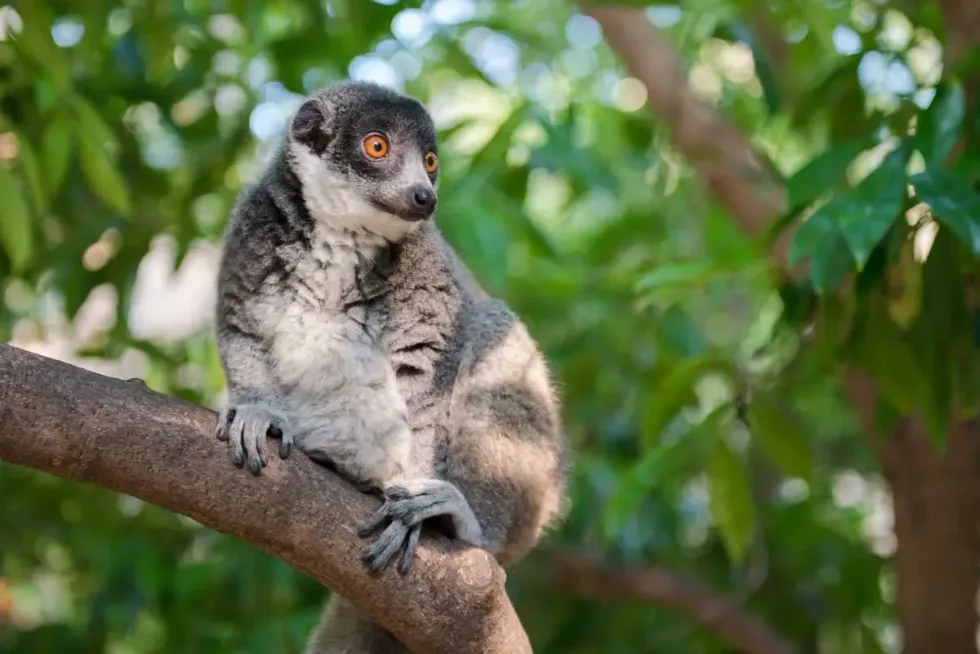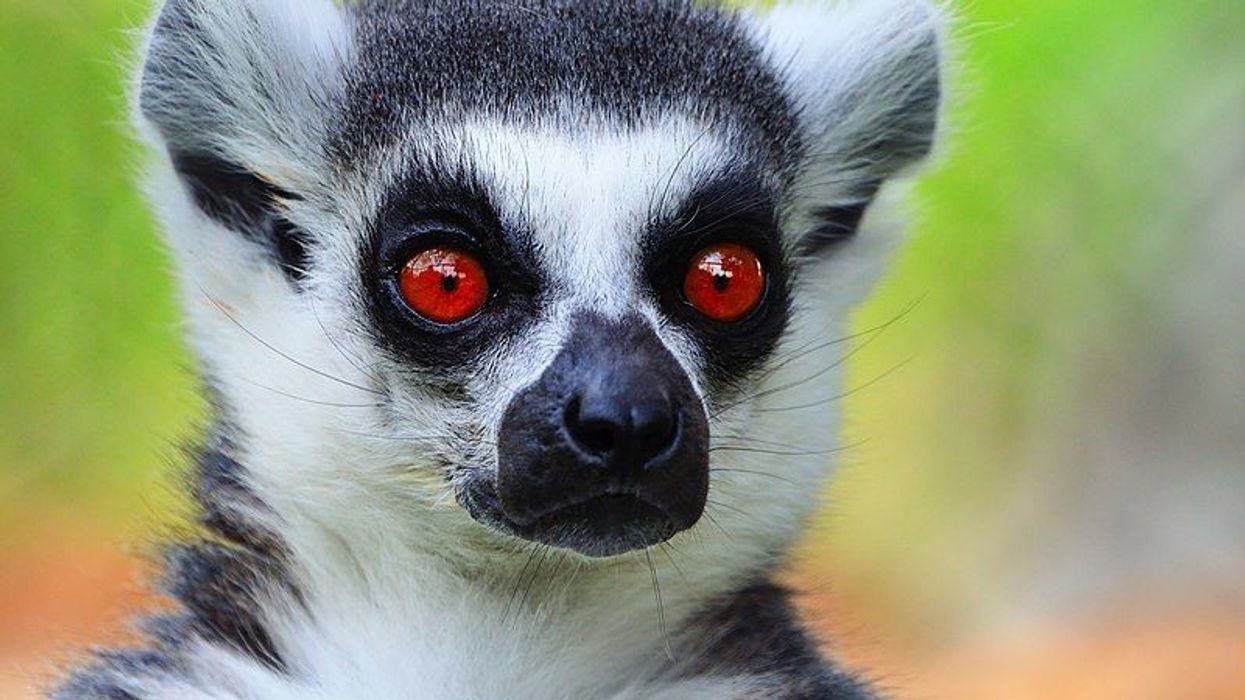The mongoose lemur (Eulemur mongoz) is a tiny lemur species known for its fluffy black and gray fur. They are nocturnal during the dry season and are native to the deciduous forests of Madagascar and the humid forests of the Comoros islands.
Unfortunately, this stunning primate is Critically Endangered. That means that if not protected, this lemur species could be extinct very soon. It would be a disaster to see them gone from our forests, so it is important to educate yourself about these beautiful animals and work to protect them.
To learn more about the mongoose lemur, keep on reading! If you are intrigued about other forest creatures, read our articles about the pygmy slow loris and the numbat.
Mongoose Lemur Interesting Facts
What type of animal is a mongoose lemur?
The mongoose lemur is a type of primate.
What class of animal does a mongoose lemur belong to?
The mongoose lemur is a mammal.
How many mongoose lemurs are there in the world?
The population of mongoose lemurs living in their natural habitat is unknown. There are around 100 mongoose lemurs living in captivity.
Where does a mongoose lemur live?
This primate lives in the forest. The mongoose lemur home range in Madagascar is mostly within the northwest of the island. They are also native in the humid forests in the Comoros Islands, a group of islands in between Madagascar and the Southeast African mainland, specifically the Moheli and Anjouan islands.
What is a mongoose lemur's habitat?
Their natural habitat is dry and deciduous forests (which means trees shed their leaves annually) in Madagascar.
Who do mongoose lemurs live with?
Mongoose lemurs live in family groups. A small group of lemurs is called troops. Usually, a troop consists of three to four lemurs. Typically they live in small families consisting of a female, male, and their offspring.
Lemurs tend to leave their family groups when they are mature and reach two or three years old. By this time, they find a mate and create their own troop.
How long does a mongoose lemur live?
Scientists believe that the mongoose lemur can live up to 36 years.
How do they reproduce?
Mongoose lemurs can be both monogamous (have one partner) or polygamous (have multiple mates). These primates reach sexual maturity at two years of age. They use sexual reproduction to produce offspring.
The mating season is from April to June. Females can give birth to one offspring each year, although they have been recorded to also be able to have twins.
Young lemurs are born in the wet season between August to October after their mother has a gestation period of approximately 128 days. Newborn lemurs are weaned from their mothers after they have been nursed for a period of 135 days. Mothers tend to do most of the care, including playing, socializing, grooming, and carrying young.
What is their conservation status?
They have a conservation status of Critically Endangered. This means without action, they could become extinct very soon. Populations are continually declining. In fact, their numbers have declined by 80% over the last 25 years.
Mongoose Lemur Fun Facts
What do mongoose lemurs look like?
Mongoose lemurs are the smallest of the genus Eulemur, the scientific name for lemur. Males and females look different. Both sexes have bushy and woolly tails that are typically gray.
Males have a gray body but red/brown fur on the sides of their bodies and also on their cheeks. Males have white beards that turn red/brown as they mature.
Females, on the other hand, have darker fur but white fur on the sides of their bodies and their face. These differences make it very easy to spot a male or a female mongoose lemur.
How cute are they?
They are exceptionally cute! Not only are they the smallest lemurs, but they have adorable big eyes and very fluffy. We also love the beards on males. It would be sad to see these beautiful creatures become extinct.
How do they communicate?
All primates have very advanced and complex systems of communication as they are all very intelligent. Mongoose lemurs can use visual communication such as facial expressions, signals, and body language. They can also communicate vocally to mark their territories or warn the group of any threats.
Mongoose lemurs also use chemical communication. They can release chemicals, scent-marking, to mark their territories, just like dogs! Mongoose lemurs also play with each other, groom each other and even tease each other.
How big is a mongoose lemur?
The mongoose lemur is not very big at all. In fact, they are quite small. They measure a range of 12-18 in (30-46 cm) in length from head to toe, and their tails are 16-25 in (41-64 cm). They are said to weigh the same as a Chihuahua, but a Chihuahua is twice as long!
How fast can a mongoose lemur move?
This species can move quite fast! They have two ways of moving: on all fours on the ground or swinging with their arms and tail between trees.
How much does a mongoose lemur weigh?
The mongoose lemur weight is quite light. They weigh between a range of 4.4-6.6 lb (2-3 kg). They are two times lighter than the Siamese cat.
What are the male and female names of the species?
A male and female are both called a mongoose lemur.
What would you call a baby mongoose lemur?
A baby mongoose lemur is called a pup. They normally weigh only 2.1-2.4 oz (60-70 g).
Young mongoose lemurs cling to their mother. At just five weeks of age, infant mongoose lemurs will begin to take their first steps away from the comfort of their mother. At this point, they start to eat solid food until they are weaned at around six months of age.
What do they eat?
During both the wet and the dry season, the diet of the mongoose lemur is mostly fruit. Fruits make up the biggest portion of their diet.
They also enjoy feeding on flowers as part of their diet, especially the flowers from the kapok tree. Mongoose lemurs love to eat nectar. As they love to feed on nectar, these species are excellent pollinators, spreading the nectar and contributing to the ecosystem of the forests on Comoros islands and Madagascar.
Mongoose lemurs are also known to have beetles and insects as part of their diet. Their biggest predator is the fossa.
Are they loud?
Mongoose lemurs are not very loud. They only seem to make loud noises when threats to their group invade their territory.
Would they make a good pet?
Although they are very cute, this species would not make a good pet. They belong in the wild and in fact, they are a Critically Endangered species. It is much better to support the conservation of mongoose lemurs by donating to organizations that want to protect them.
Did you know...
The mongoose lemur is only one of two species of lemur found outside of Madagascar island, apart from the ring-tailed lemur. If you take the whole world into the equation, there are only about 100 kinds of lemurs left. Around one-third of lemur species are now extinct.
They are nocturnal (awake at night) during the dry season but diurnal (awake during the day) during the wet season. Foraging at night when it is dry season and hot makes it easier to search for food.
They live in a female-dominated society. The female also chooses their mate, diet, and food for the small family group.
These lemurs have a very strong sense of smell, which helps with communication through scent making.
When grooming each other, they use their teeth from the lower jaw as a tooth comb.
Why are mongoose lemurs endangered?
Mongoose lemurs are a Critically Endangered species. The main reason for them being critically endangered is that their habitat is being destroyed. Deforestation, the removal of trees, to develop land for farming has removed much of their habitat.
These mongoose lemurs may also be hunted by humans. It is actually illegal to kill lemurs since 1974, but somehow this keeps on happening to this species, even if not intentionally.
How did mongoose lemurs get their name?
The lemur's name comes from the Latin word lemures, which are ghosts. The lemur species were given this name because they like to be awake at night. These lemurs are named after mongoose because they share the same size and black and gray fur.
Here at Kidadl, we have carefully created lots of interesting family-friendly animal facts for everyone to discover! Learn more about some other mammals from our mongoose facts and coatimundi fun facts pages.
You can even occupy yourself at home by coloring one of our free printable mongoose lemur coloring pages.










